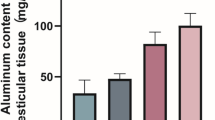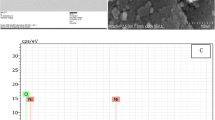Abstract
The number of industrial and consumer products which contain engineered nanomaterials (ENMs, materials with at least one dimension 1–100 nm) are increasing exponentially and there is a concern regarding their occupational and environmental safety. Fe3O4 nanoparticles are the most widely used metal oxide nanoparticles especially, in biomedical applications. Although, nanoparticles can enter to the different organs, little is known so far on the toxicity potential and oxidative stress of Fe3O4. Here the understanding of the effect of Fe3O4 nanoparticles on the general Redox state of a unicellular protozoa Paramecium and the effect on mitochondrial swelling and respiration were assessed. Fe3O4 resulted in increase of toxicity markers, lipid peroxidation, protein and ROS formation. Mitochondrial enzymes and swelling were elevated with decreased respiration level. Caspase 3 activity was also increased.
Finally, our study suggested that the mitochondrial disease and dysfunction with elevated oxidative stress in Paramecia treated with 200 and 300 ppm during 15 days is the original of toxicity and maybe the original cause of many environmental pathologies.
Similar content being viewed by others
References
Gottschalk, F., Kost, E. & Nowack, B. Engineered nanomaterials in water and soils: a risk quantification based on probabilistic exposure and effect modeling. Environ. Toxicol. Chem. 32, 1278–1287 (2013).
Chen, C. L. et al. A New Nano-sized Iron Oxide Particle with High Sensitivity for Cellular Magnetic Resonance Imaging. Mol. Imag. Biol. 13, 825–839 (2010).
Alexiou, C., Tietze, R., Schreiber, E. & Lyer, S. Nanomedicine: Magnetic nanoparticles for drug delivery and hyperthermia -new chances for cancer therapy. Bundesgesundheitsblatt Gesundheitsforschung. Gesundheitsschutz 53, 839–845 (2005).
McBain, S. C., Yiu, H. H. P. & Dobson, J. Magnetic nanoparticles for gene and drug delivery. Int. J. Nanomedicine. 3, 169–180 (2008).
Puppi, J. et al. Use of a Clinically Approved Iron Oxide MRI Contrast Agent to Label Human Hepatocytes. Cel. Transplant. 20, 963–975 (2011).
Rümenapp, C., Gleich, B. & Haase, A. Magnetic Nanoparticles in Magnetic Resonance Imaging and Diagnostics. Pharm. Res. 29, 1165–1179 (2012).
Cochran, D. B. et al. Suppressing iron oxide nanoparticle toxicity by vascular targeted antioxidant polymer nanoparticles. Biomaterials 34, 9615–9622 (2013).
Zhu, M. T. et al. Oxidative stress and apoptosis induced by iron oxide nanoparticles in cultured human umbilical endothelial cells. J. Nanosci. Nanotechnol. 10, 8584–8590 (2010).
Wilson, M. R. et al. Interactions between ultrafine particles and transition metals in vivo and in vitro. Toxicol. Appl. Pharmacol. 184, 172–179 (2002).
Zhu, M. T. et al. Endothelial dysfunction and inflammation induced by iron oxide nanoparticle exposure: risk factors for early atherosclerosis. Toxicol. Lett. 203, 162–171 (2011).
Remyaa, A. S. et al. Iron oxide nanoparticles to an Indian major carp, Labeo rohita: Impacts on hematology, iono-regulation and gill Na+/K+ ATPase activity. J. of King Saud University Science. 27, 151–160 (2015).
Gräbsch, C. et al. Cytotoxicity assessment of Gliotoxin and Penicillic acid in Tetrahymena pyriformis. Environ. Toxicol. 21, 111–117 (2006).
Van der Oost, R., Beyer, J. & Vermeulen, N. P. E. Fish bioaccumulation and biomarkers in environmental risk assessment: a review. Environ. Toxicol. Phar. 13, 57149 (2003).
Dive, D. et al. A bioassay using the measurement of the growth inhibition of a ciliate protozoan: Colpidium campylum stokes. Hydrobiologia 188/189, 181–188 (1989b).
Nalecz-Jawecki, G., Demkowicz-Dobrzahski, K. & Sawicki, J. Protozoan Spirostomum ambiguum as a highly sensitive bioindicator for rapid and easy determination of water quality. Sci. Total Environ. Suppl. 134, 1227–1234 (1993).
Foissner, W. Soil protozoa as bioindicators: pros and cons, methods, diversity, representative examples. Agr. Ecosyst. Environ. 74, 95–112 (1999).
Rouabhi, R., Djebar, H. & Djebar, M. R. Toxicity evaluation of Flucycloxuron and diflubenzuron on the cellular model. Paramecium sp. Afr. J. Biotechnol. 5, 45–48 (2006a).
Rouabhi, R., Djebar-Berrebbah, H. & Djebar, M. R. Toxic Effect of a Pesticide. Diflubenzuron on Freshwater Macroinvertebrate (Tetrahymena pyriformis). Chin. J. Appl. Environ. Biol. 12, 514–517 (2006b).
Mohd, M. H., Nageswara, R. A., Venkata, R. S. & Mohan, B. Low cost micro bioassay test for assessing cytopathological and physiological responses of ciliate model Paramecium caudatum to carbofuran pesticide. Pest. Biochem. Physiol. 90, 66–70 (2008).
Krejc, S. et al. Chronic effects of metals. organophosphates and polycyclic aromatic hydrocarbon (PAH) on Tetrahymena pyriformis. Toxicol. Lett. 172S, S84–S85 (2007).
Kovács, P., Csaba, G., Pallinger, E. & Czaker, R. Effects of taxol treatment on the microtubular system and mitochondria of Tetrahymena. Cell Biol. Int. 31, 724–732 (2007).
Guiraud, P. et al. Involvement of Tetrahymena pyriformis and selected fungi in the elimination of anthracene. and toxicity assessment of the biotransformation products. Ecotox. Environ. Safe. 69, 296–305 (2008).
LeRoith, D. et al. Are messenger moleculs in microbes the ancestors of the vertebrate hormones and tissue factors? Fed. Proc. 42, 2602–2607 (1983).
Csaba, G. & Kovács, P. Localization of β-endorphin in Tetrahymena by confocal microscopy. Induction of the prolonged production of the hormone by hormonal imprinting. Cell Biol. Int. 23, 695–702 (1999).
Ashley, R. M. et al. Oxidative Stress and Dermal Toxicity of Iron Oxide Nanoparticles in Vitro. Cell Biochem. Biophys. 67, 461–476 (2013).
Rouabhi, R., Gasmi, S., Boussekine, S. & Kebieche, M. Hepatic Oxidative Stress Induced by Zinc and Opposite Effect of Selenium in Oryctolagus cuniculus. J. Environ. Anal. Toxicol. 5, 289 (2015).
García, A. et al. Acute toxicity of cerium oxide. titanium oxide and iron oxide nanoparticles using standardized tests. Desalination 269, 136–141 (2011).
Rouabhi, R., Djebar-Berrebbah, H. & Djebar, M. R. Impact of Flufenoxuron. an IGR pesticide on Gallus domesticus embryonic development in ovo. J. Cell Anim. Biol. 2, 87–91 (2008).
Aruoja, V. et al. Toxicity of 12 metal-based nanoparticles to algae. bacteria and protozoa. Environ. Sci.: Nano. 2, 630–644 (2015).
Alnemri, E. S. et al. Human ICE/CED-3 protease nomenclature. Cell 87, 171 (1996).
Salvesen, G. S. Caspases: opening the boxes and interpreting the arrows. Cell Deat. Differ. 9, 3–5 (2002).
Ghavami, S. et al. Apoptosis and cancer: mutations within caspase genes. J. Med. Genet. 46, 497–510 (2009).
Boatright, K. M. & Salvesen, G. S. Mechanisms of caspase activation. Curr. Opin. Cel. Biol. 15, 725–731 (2003).
Zhao, X. et al. TNF-alpha stimulates caspase-3 activation and apoptotic cell death in primary septo-hippocampal cultures. J. Neurosci. Res. 64, 121–131 (2001).
Utaisincharoen, P. et al. TNF-alpha induces caspase 3 (CPP 32) dependent apoptosis in human cholangiocarcinoma cell line. Southeast Asian J. Trop. Med. Publi. Health. 31, 167–170 (2000).
Zou, X.-Y., Xu, B., Yu, C.-P. & Zhang, H.-W. Combined toxicity of ferroferric oxide nanoparticles and arsenic to the ciliated protozoa Tetrahymena pyriformis. Aquat. Toxicol. 134-135, 66–73 (2013).
Yang, S., Thor, A. D., Edgerton, S. & Yang, X. Caspase3 mediated feedback activation of apical caspases in doxorubicin and TNF-alpha induced apoptosis. Apoptosis 11, 1987–1997 (2006).
Zhang, G. et al. Hydroxycamptothecin-Loaded Fe3O4 Nanoparticles Induce Human Lung Cancer Cell Apoptosis through Caspase-8 Pathway Activation and Disrupt Tight Junctions. Cance. Sci. 102, 1216–1222 (2011).
Baratli, Y. et al. Age Modulates Fe3O4 Nanoparticles Liver Toxicity: Dose-Dependent Decrease in Mitochondrial Respiratory Chain Complexes Activities and Coupling in Middle-Aged as Compared to Young Rats. BioMed Res. Int. (2014). DOI:10.1155/2014/474081.
Kakkar, P., Das, B. & Viswanathan, P. A modified spectrophotometric assay of superoxide dismutase. Indian J. Biochem. Biophys. 21, 130–132 (1984).
Flohe, L. & Gunzler, W. A. Assays of glutathione peroxidase. Method. Enzymol. 105, 114–121 (1984).
Cakmak, I. & Horst, W. J. Effect of aluminum on lipid peroxidation, superoxide dismutase, catalase, and peroxidase activities in root tips of soybean (Glycine max). Physiol. Plantarum. 83, 463–468 (1991).
Habig, H., Pabst, M. J. & Jokoby, W. B. GlutathioneS-transferase: the first enzymatic step in mercapturic acid formation. J. Biol. Chem. 249, 7130–7139 (1974).
Weckbker, G. & Cory, J. G. Ribonucleotide reductase activity and growth of Glutathoine-depleted mouse leukemia L1210 cells in vitro. Cance. Lett. 40, 257–264 (1988).
Esterbaer, H., Gebicki, J., Puhl, H. & Jungens, G. The role of lipid peroxidation and antioxidants in oxidative modification of LDL. Free Radic. Biol. Med. 13, 341 (1992).
Bradford, M. A rapid and sensitive method for the quantities of microgram quantities of protein utilizing the principle of protein binding. Anal. Biochem. 72, 248–254 (1976).
Kristal, B. S., Park, B. K. & Yu, B. P. 4-hydroxynonénal est un puissant inducteur de la transition de perméabilité mitochondriale. J. Biol. Chem. 271, 6033–6038 (1996).
Rouabhi, R., Djebar, H. & Djebar, M. R. Toxic Effects of Combined Molecule from Novaluron and Diflubenzuron on Paramecium caudatum. Am-Euras. J. Toxicol. Sci. 1, 74–80 (2009).
Author information
Authors and Affiliations
Corresponding author
Rights and permissions
About this article
Cite this article
Sara, H., Rachid, R., Salim, G. et al. Oxidative stress status, caspase-3, stromal enzymes and mitochondrial respiration and swelling of Paramecium caudatum in responding to the toxicity of Fe3O4 nanoparticles. Toxicol. Environ. Health Sci. 8, 161–167 (2016). https://doi.org/10.1007/s13530-016-0273-1
Received:
Revised:
Accepted:
Published:
Issue Date:
DOI: https://doi.org/10.1007/s13530-016-0273-1




